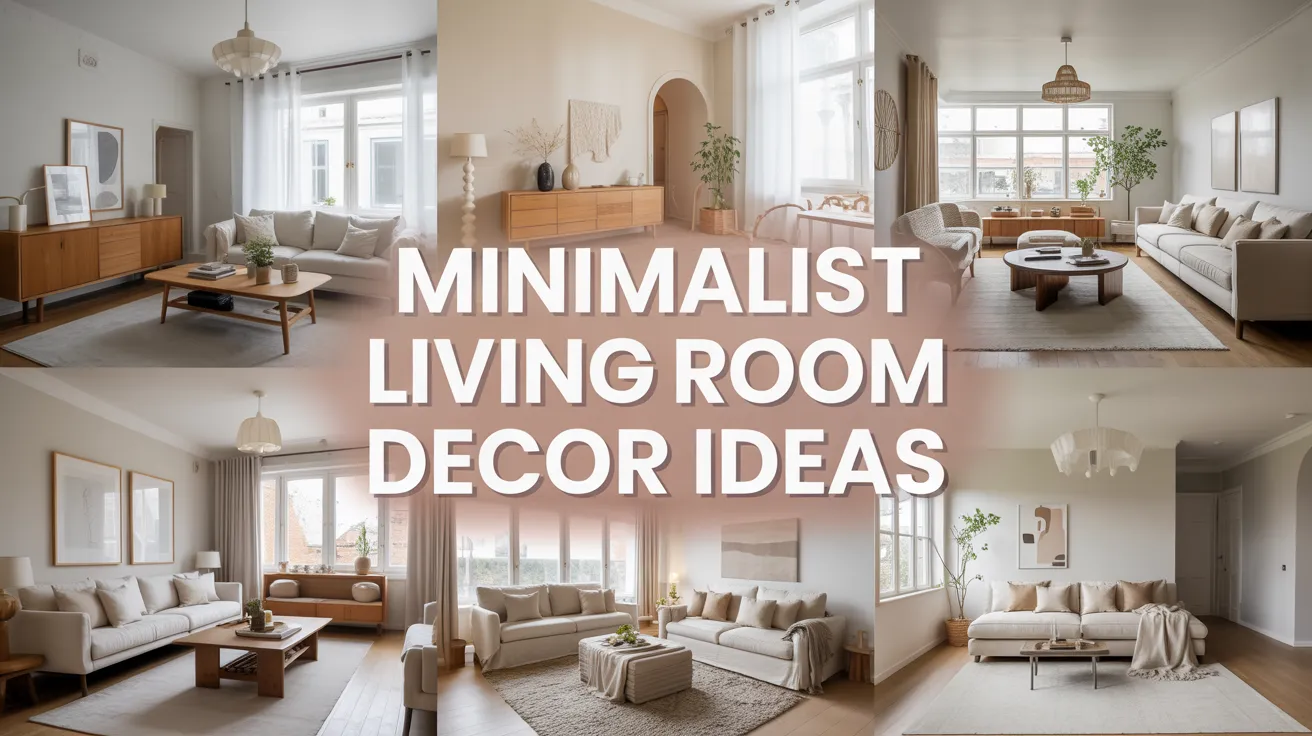The Ultimate Guide to Minimalist Living Room Decor for a Peaceful Home
Every home tells a story, and your living room is where it begins. After long days and endless noise, you crave a space that feels quiet, clean, and deeply personal a place where every piece has meaning and every corner breathes calm. Minimalist living room design isn’t about stripping life away; it’s about clearing space for it to thrive.
You don’t need lavish furniture or bold patterns to make your space feel beautiful. What you need is balance soft textures, thoughtful lighting, natural tones, and furnishings that reflect who you are. When simplicity meets intention, even the smallest room can feel spacious and soothing.
Whether you love Scandinavian minimalism, modern neutral palettes, or organic warmth, these minimalist living room decor ideas help you create a home that feels effortless yet complete. Each idea is a step toward comfort, clarity, and understated elegance that speaks louder than clutter ever could.
Soft Neutrals with Natural Light

A minimalist living room begins with softness and light. Choose a neutral color palette of warm whites, sand, and stone that reflects daylight beautifully. Keep windows open or dress them in sheer linen curtains to invite natural sunlight. The glow makes your room feel calm and airy while enhancing the clean lines of minimalist design.
Bring life to the space through layers of texture instead of color. Mix jute rugs, linen cushions, and smooth oak finishes. Each texture creates quiet contrast without cluttering the aesthetic. Add an olive tree or a leafy plant for a breath of freshness that softens the space naturally.
Every piece should earn its place. A simple ceramic vase, a low wooden coffee table, or a woven basket can complete your minimalist setup. When everything feels intentional, your living room turns into a sanctuary of calm balance and effortless style.
Low Furniture and Open Space Layout

Open layouts define modern minimalist living rooms. Low-profile furniture keeps your eyes moving across the room, creating a sense of openness. Choose a sofa with clean lines and short legs, paired with a sleek coffee table in light wood or marble. The lower height visually expands the space, making ceilings appear taller.
Keep the color palette restrained. Soft grays, ivory, or pale taupe work beautifully with natural textures like cotton or wool. Leave breathing room between pieces—this spacing is what gives minimalism its signature calm.
Avoid overcrowding your design. A single wall art piece, a slim floor lamp, and a neutral rug are all you need to define the space. The balance between simplicity and comfort gives your living room a grounded, welcoming atmosphere.
Hidden Storage for Effortless Minimalism
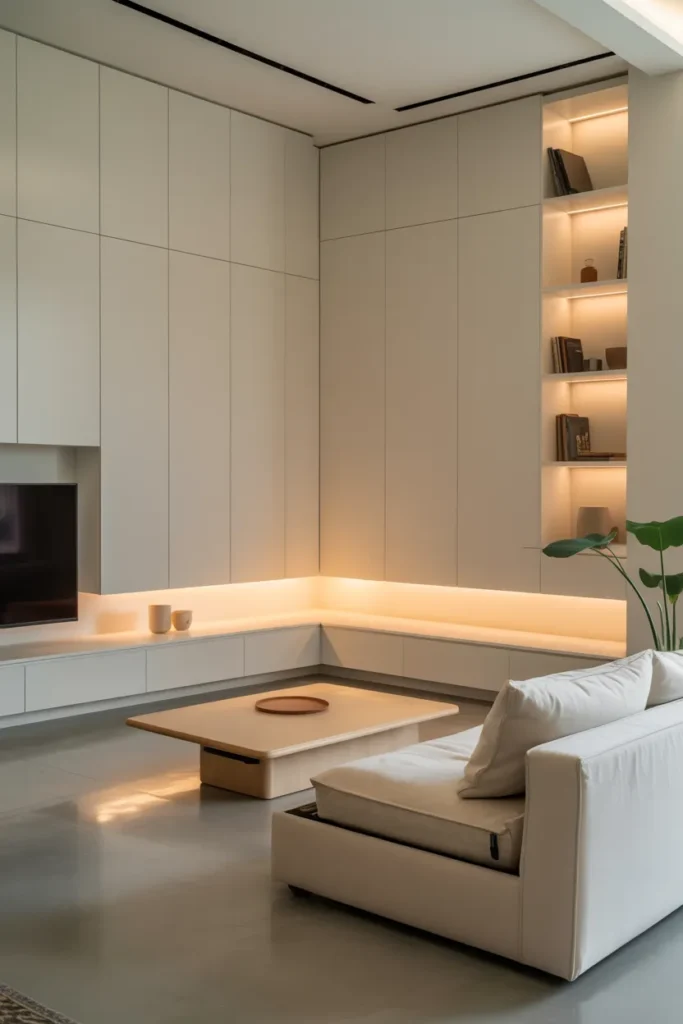
Clean lines rely on invisible organization. Hidden storage solutions help you maintain that pristine minimalist living room look without sacrificing practicality. Choose coffee tables with built-in drawers, storage benches, or modular cabinets with smooth doors that blend into the wall.
Every hidden compartment keeps visual noise out of sight. Store remotes, books, and throw blankets neatly inside. The fewer items you see, the calmer your environment feels. Use soft LED lighting to create warm highlights without adding clutter.
Combine functionality with style through natural finishes. Think matte oak, birch veneer, or stone textures that add subtle depth. When your furniture hides the mess but still looks beautiful, your living room embodies the essence of minimalist modern design peaceful, purposeful, and endlessly livable.
Monochrome Layers and Texture Play

Monochrome spaces make minimalism look refined and effortless. Start with one color family beige, gray, or white and layer different tones across the room. The variation adds depth without overwhelming the eye. A matte wall beside a polished concrete floor or a wool sofa with smooth leather cushions brings natural contrast.
Focus on texture instead of pattern. Natural linen, brushed steel, and raw wood bring interest while keeping your palette restrained. The combination feels sophisticated yet serene, reflecting the balance of modern minimalism and Scandinavian simplicity.
Keep accessories quiet but meaningful. A round mirror, a stone tray, or a single sculptural vase works better than a dozen small accents. Each detail feels thoughtful, letting the monochrome scheme breathe and stay timeless.
Sculptural Lighting as a Centerpiece
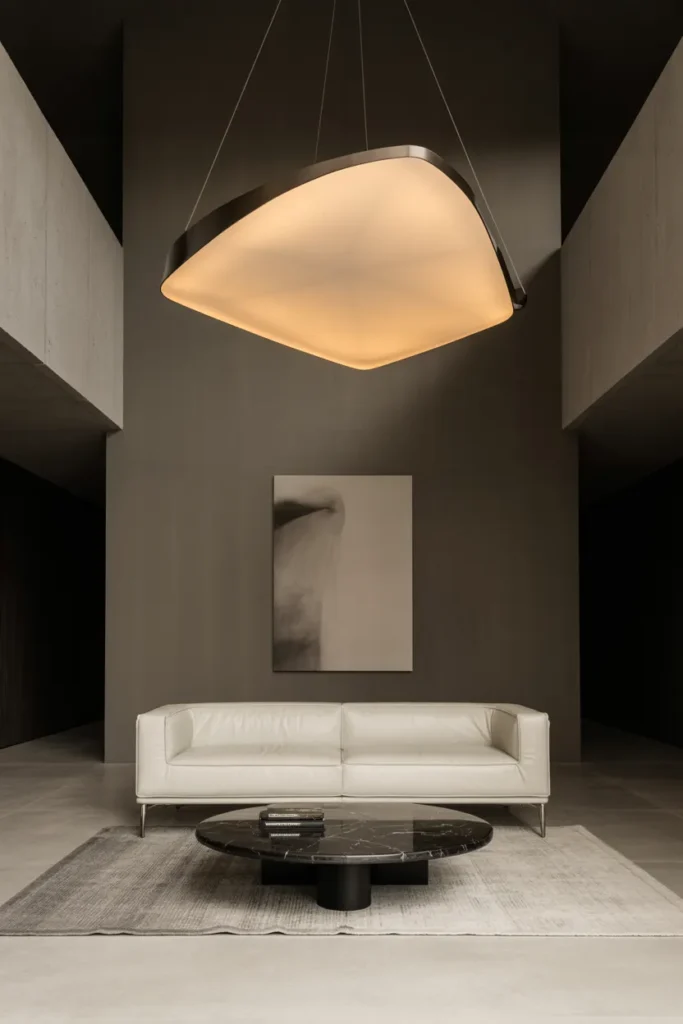
Lighting can transform your minimalist living room design into a masterpiece. A single sculptural pendant light or an arched floor lamp can anchor the entire room. Choose clean shapes in black, white, or brushed brass. Their elegance lies in simplicity, not excess.
Let lighting guide your layout. Position a statement lamp near a corner reading chair or a slim chandelier above your center table. The right glow adds dimension and warmth to every surface. Use warm tone bulbs that cast soft light over your neutral color scheme.
When light meets form, your space comes alive. Every shadow feels deliberate, every curve adds art. It’s a minimalist approach to lighting that feels modern, luxurious, and human.
Natural Wood Accents for Warm Minimalism
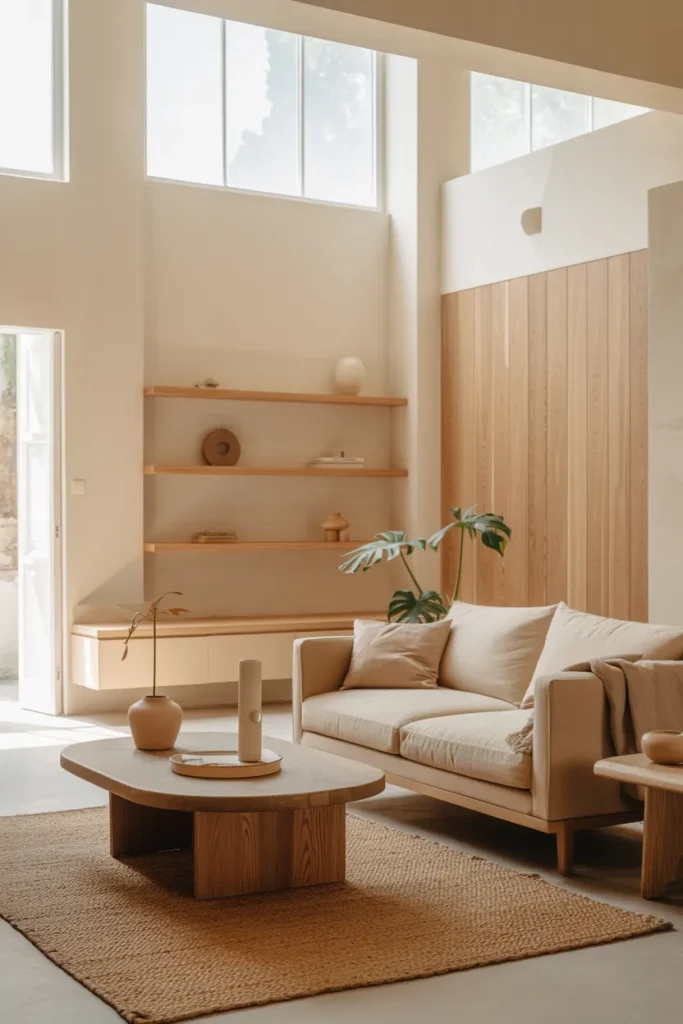
Wood adds warmth and soul to minimalist living room design. Light oak, ash, or maple brings a natural softness that balances sleek furniture and crisp walls. A simple wooden console, coffee table, or open shelving instantly creates texture and comfort.
Pair wood with neutral tones like ivory, beige, or pale gray. The contrast highlights the wood grain and makes the space feel cozy but uncluttered. Keep finishes matte or raw to preserve that organic look.
Add one or two wood focused pieces instead of covering everything. A framed wood mirror or a low wood bench can make a quiet yet striking statement. It’s the perfect balance of Scandinavian simplicity and natural modern minimalism.
Touch of Green with Indoor Plants

Greenery brings life to a minimalist space without breaking its calm energy. A single statement plant a fiddle leaf fig, snake plant, or olive tree adds texture and freshness. Choose clean ceramic pots or woven baskets to stay consistent with the aesthetic.
Position plants thoughtfully. Corners, open shelves, or beside the sofa work well to soften edges and add a natural focal point. Keep the rest of your color palette neutral so the green stands out beautifully.
For a more grounded vibe, mix plants of different heights and leaf shapes. You’ll find they bring an organic rhythm that keeps your minimalist living room from feeling sterile. Natural elements always make simplicity feel alive.
Statement Art on Clean Walls
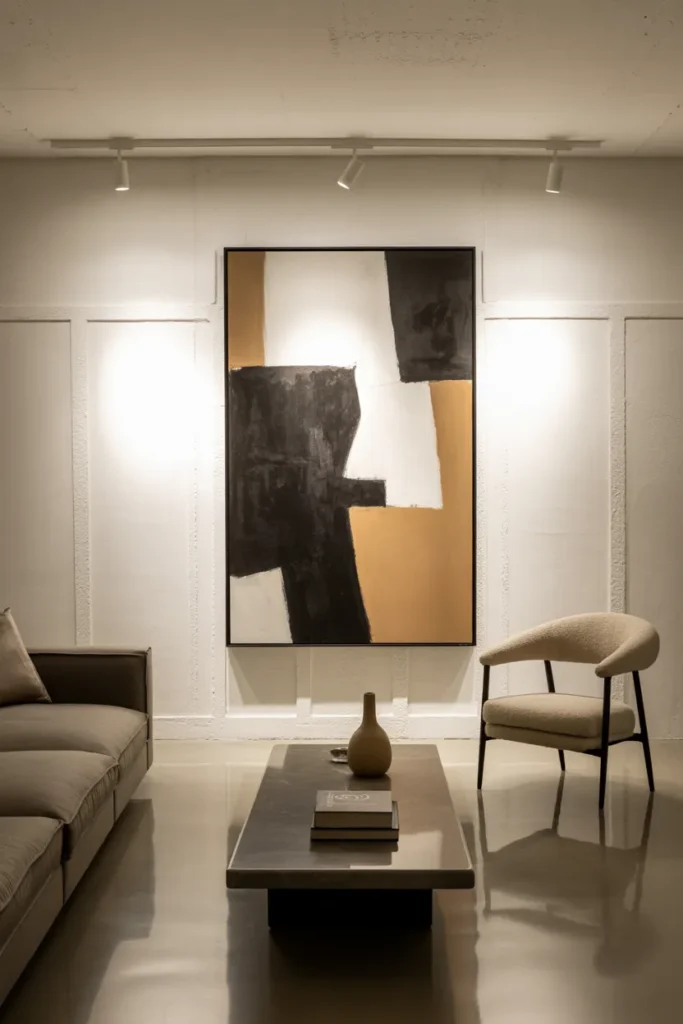
Minimalism doesn’t mean blank walls. A single large scale artwork or abstract print can bring personality without chaos. Go for clean compositions, muted tones, or black-and-white photography to maintain the minimalist flow.
Choose frames that blend seamlessly with your room wood, white, or black are timeless. Center the piece above your sofa or console table, and let it breathe with negative space around it. This creates visual impact without crowding your design.
Art in a minimalist living room should evoke emotion, not distraction. When chosen thoughtfully, one painting can carry the entire mood of your space while keeping it elegant and modern.
Layered Lighting for Subtle Drama
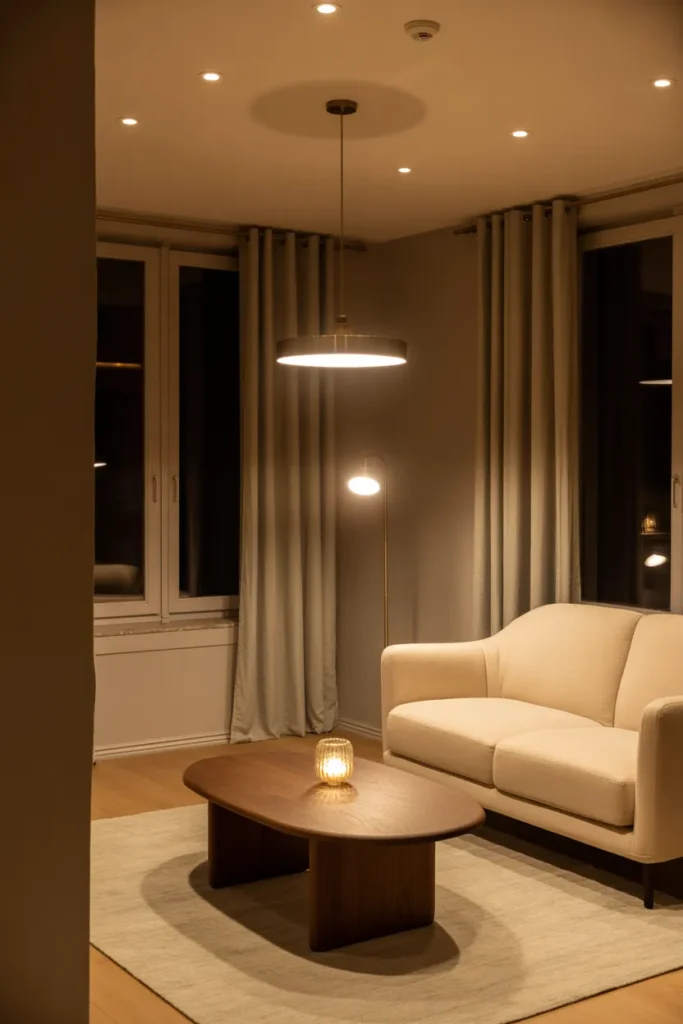
A minimalist living room shines when lighting feels balanced and layered. Use multiple soft sources instead of one harsh overhead light. Think wall sconces, slim floor lamps, or small table lamps with warm bulbs. Each layer builds mood and function.
Place lighting to highlight textures and shadows. Let a warm beam wash over your linen curtains or bounce off a matte wall. These subtle touches add depth and sophistication to your minimalist design.
Avoid ornate fixtures. Instead, focus on sculptural simplicity shapes that blend function and form. The right lighting makes even a quiet room glow with quiet luxury.
Functional Minimal Coffee Table Styling
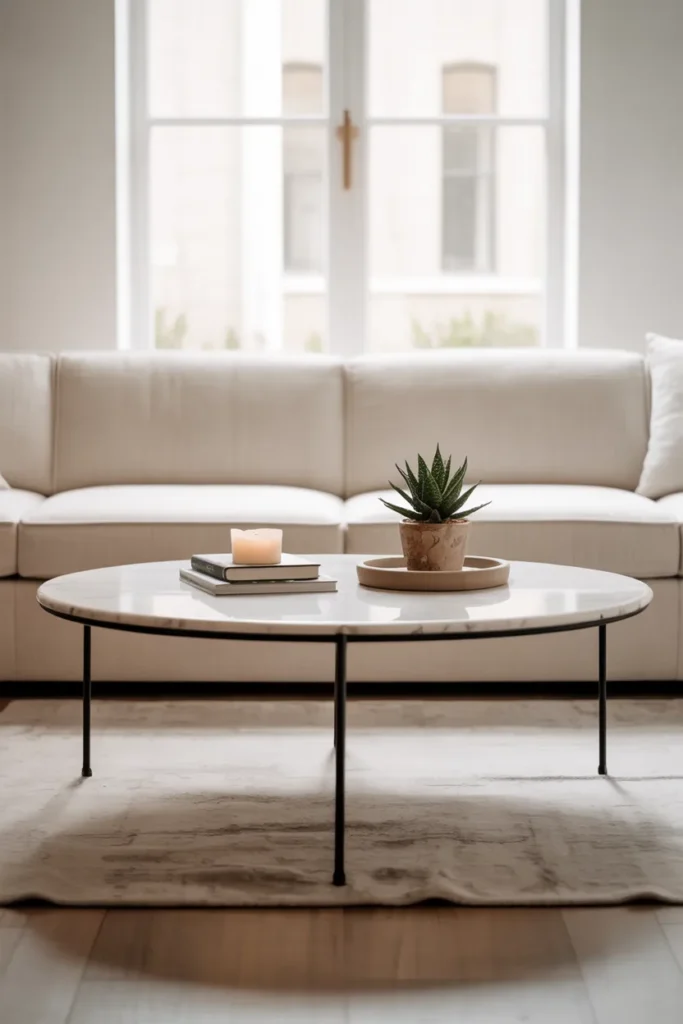
The coffee table anchors your living room, but in minimalism, it must stay light and intentional. Choose a sleek surface marble, glass, or matte wood and keep only a few curated items on top. A book stack, small tray, or single candle is enough.
Use your table to express quiet style without clutter. A balanced composition of textures smooth ceramic beside soft linen feels thoughtful and natural. Each object should serve a purpose or spark a feeling.
Keep the area around your table spacious to preserve flow. The emptiness around it amplifies beauty. When styled right, your minimalist coffee table becomes a symbol of calm focus and refined simplicity.
Floating Shelves for Airy Organization
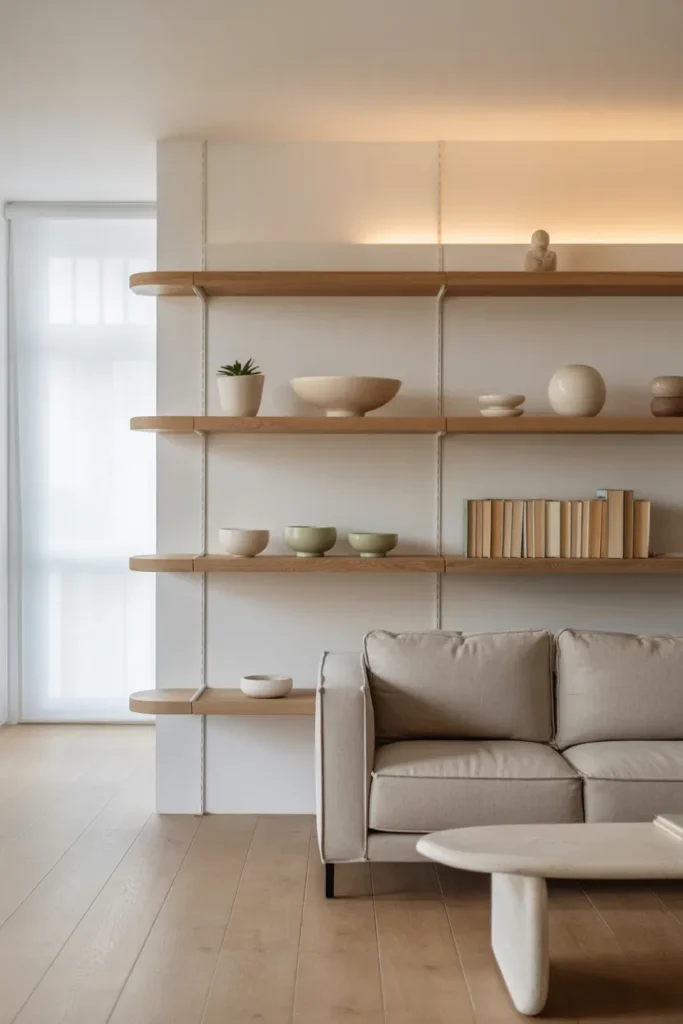
Floating shelves bring lightness and utility to minimalist living room design. Their clean lines keep storage open while eliminating bulky furniture. Choose slim wooden or matte white shelves that blend into the wall for an uncluttered feel.
Display only what matters a few books, a candle, or a framed print. Group objects by color and spacing so the shelf looks balanced, not crowded. The open structure helps your space breathe while still offering function.
Use symmetry when stacking shelves or place one long piece across the wall for a linear effect. This small detail adds visual flow, guiding the eye naturally through your room’s layout.
Textured Neutrals for Visual Warmth
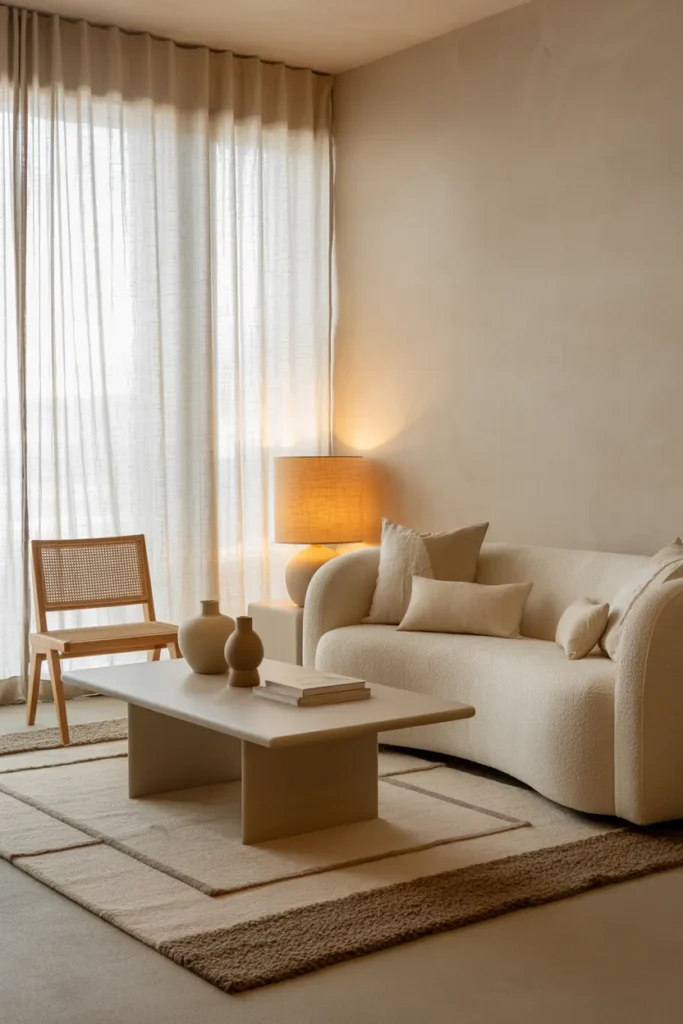
A minimalist palette doesn’t mean flat design. Layering textures adds warmth and movement to your living room without disturbing its calm tone. Start with soft fabrics like linen, boucle, or cotton in whites, creams, and grays.
Mix smooth and rough surfaces to create quiet interest. A wool rug beside a leather chair, or a clay vase next to polished wood, invites touch and keeps the space dynamic. Natural materials are key here they age beautifully and add character.
Stay within a cohesive palette to maintain harmony. Texture is your tool for depth, not color. The result feels cozy, sophisticated, and undeniably minimalist.
Floor-to-Ceiling Curtains for Height and Flow
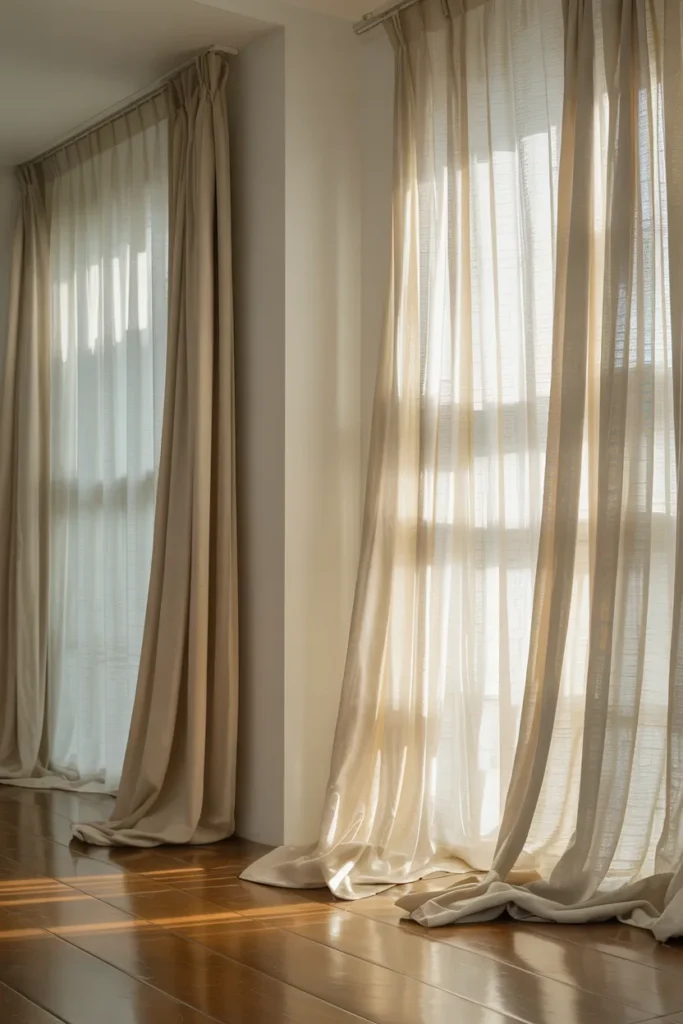
Tall curtains can transform even a small minimalist living room. Mount your curtain rod close to the ceiling and let the fabric touch the floor. The vertical lines elongate the room, making it feel taller and more open.
Choose lightweight fabrics like linen, cotton, or voile in neutral shades. They move gently with the breeze and soften sunlight, creating a serene atmosphere. Avoid heavy drapes they break the simplicity and absorb too much light.
Keep the design clean with no visible hardware or patterns. The goal is seamless flow, not distraction. When sunlight filters through sheer fabric, your living room glows with soft, natural warmth.
Minimalist Fireplace with Clean Lines
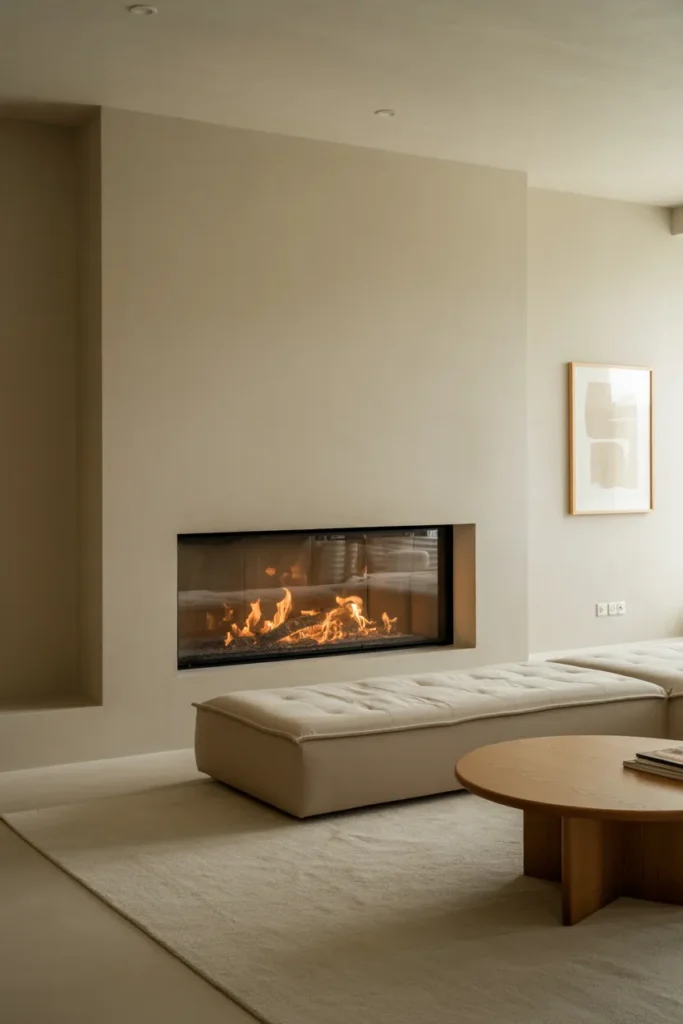
A minimalist fireplace becomes a natural focal point when designed with restraint. Go for smooth stone, concrete, or plaster finishes in light tones. Keep the mantle simple or remove it entirely for a sleek, contemporary look.
Arrange minimal decor around it a tall vase, a single framed print, or stacked firewood for warmth and texture. Let negative space frame the fireplace so it feels intentional and grounded.
Balance the visual weight with a neutral rug or low sofa nearby. The contrast of fire’s glow against pale walls captures minimalist beauty at its purest calm, refined, and deeply inviting.
Black Accents for Modern Contrast

Touches of black add boldness to a minimalist living room without overpowering the space. Use them sparingly black metal frames, floor lamps, or small decor pieces define structure and create visual balance.
Contrast is essential in minimalist interiors. Black anchors the lighter palette and prevents the room from feeling too airy or washed out. A single dark accent in an otherwise white space adds instant depth.
Pair these details with natural textures like rattan, wood, or linen to keep warmth in the mix. The balance of light and dark gives your room a refined, contemporary minimalism that feels confident and timeless.
Floor Seating for Relaxed Minimalism
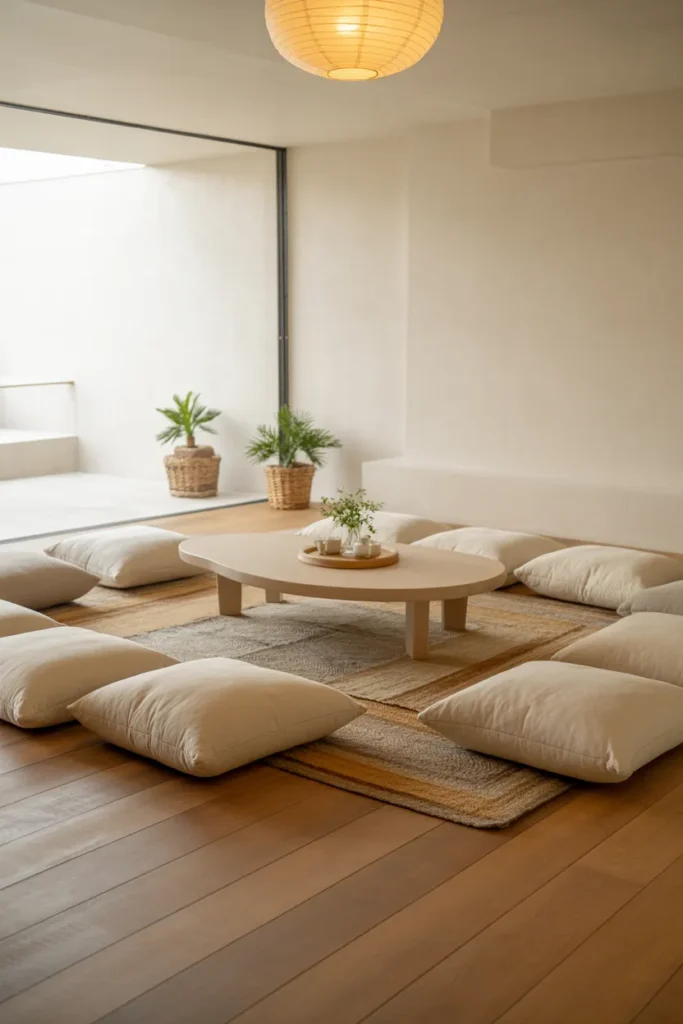
Floor seating brings a cozy, grounded vibe to minimalist living room design. Use low cushions, poufs, or a modular floor sofa to create an informal space for relaxation. This setup keeps the visual line low and makes the room feel open and spacious.
Layer natural fabrics like cotton or linen in warm neutral tones. Add a soft rug underneath to anchor the area and define the seating zone. The tactile textures make the space comfortable without cluttering it.
Keep surrounding furniture light and minimal a side table, small planter, or reading lamp works perfectly. This relaxed approach to seating promotes connection, mindfulness, and simplicity all at once.
Glass and Metal Details for a Modern Edge

Combining glass and metal adds a subtle urban sophistication to your minimalist living room. Think tempered glass coffee tables, chrome floor lamps, or brushed steel shelving. These reflective surfaces amplify natural light and enhance clean geometry.
To prevent the space from feeling cold, pair these materials with warm neutrals and organic fabrics. A linen sofa beside a glass-top table or a jute rug beneath a steel frame adds balance. Every texture complements the next.
The mix of hard and soft materials keeps your design visually engaging. It’s a modern minimalist technique that delivers elegance without excess.
Floating TV Console for Clean Lines

A floating TV console keeps your living room clutter free and modern. Mounted directly on the wall, it opens floor space and maintains smooth visual flow. Choose a unit in matte white, light oak, or soft gray to blend with your wall color.
Hide cables inside the console for a seamless finish. You’ll notice how the room instantly feels tidier and more spacious. The clean surface gives you room for one or two decorative objects maybe a ceramic vase or framed photo.
This minimalist TV setup not only looks sleek but also feels practical. It keeps attention on your design rather than the devices, allowing technology to fit quietly into your serene space.
Large Area Rugs for Cohesion
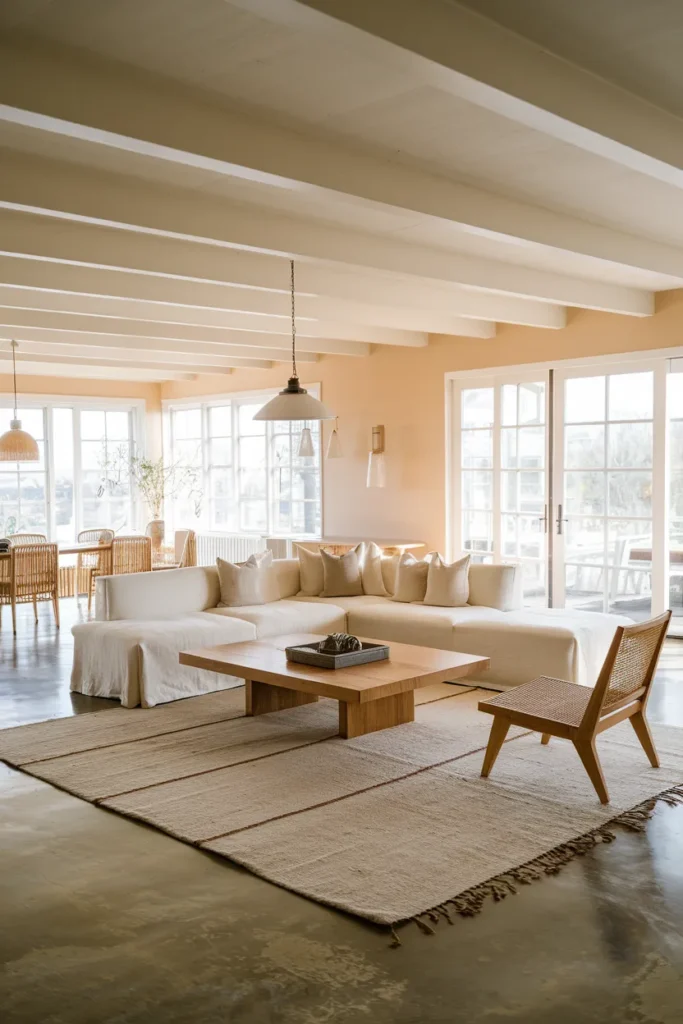
A large area rug grounds your minimalist living room and ties every element together. Choose one in a soft neutral shade like cream, sand, or taupe with subtle texture instead of bold patterns. It defines the seating area and softens the hard surfaces.
Natural fibers such as wool, jute, or cotton feel warm underfoot and enhance the organic flow of your design. The larger the rug, the more unified your space feels especially in open concept layouts.
Pair it with a simple coffee table or floor cushions to keep the focus on comfort and calm. The rug becomes your invisible anchor, creating harmony and warmth without breaking minimalism’s clean rhythm.
Accent Chair with Sculptural Form

One striking accent chair can change the entire mood of a minimalist living room. Look for sculptural shapes curved backs, slim legs, or asymmetrical forms that act like art pieces. Choose natural tones or soft textures that blend with your palette.
Place the chair near a window, reading lamp, or corner to create a subtle focal point. Keep other furniture minimal so the chair stands out through form, not color. The visual contrast gives your room quiet sophistication.
This design move reflects true minimalist thinking less furniture, more intention. A single piece, chosen wisely, makes a strong and lasting impression.
Layered Whites for Serene Harmony
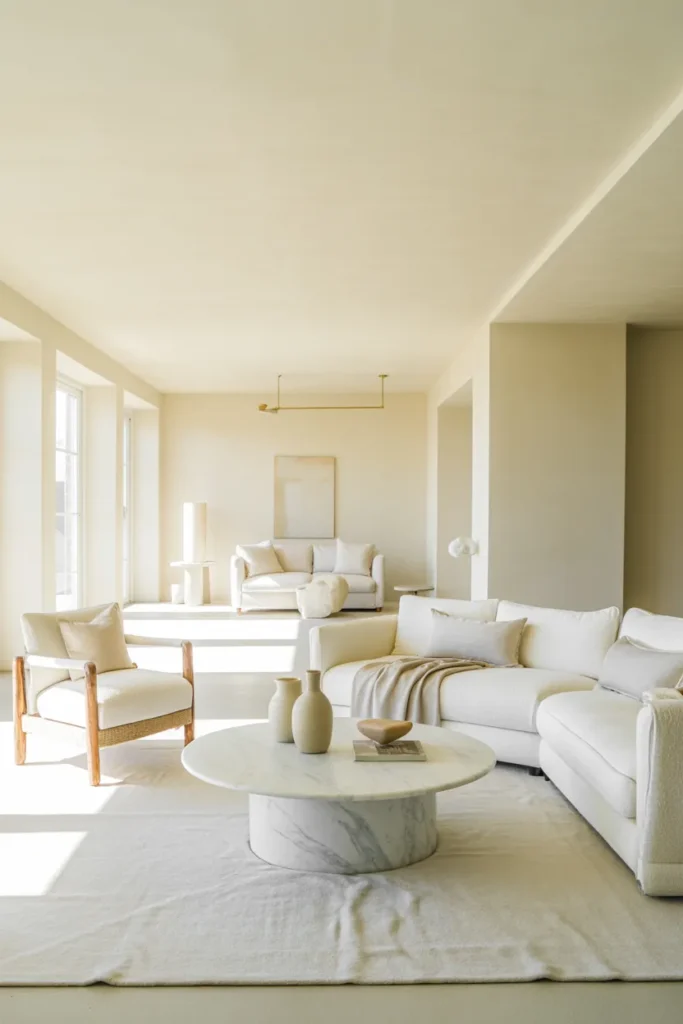
A white on white palette never goes out of style in minimalist living room design. Use multiple shades of white cream, ivory, eggshell to create layers of soft tone. This approach adds quiet depth while keeping the atmosphere calm and pure.
Play with materials to prevent monotony. A boucle sofa beside a matte plaster wall or a woven cotton rug under a marble coffee table makes each surface distinct. Every layer reflects light differently, enhancing natural brightness.
Finish the look with a single wooden accent or black metal lamp for contrast. The space feels peaceful, modern, and effortlessly elegant a true reflection of minimalist serenity.
Statement Mirror for Spacious Effect

A large wall mirror instantly expands your minimalist living room. It reflects light, opens sightlines, and doubles the sense of space. Go for a frameless mirror for seamless integration or a thin black or brass edge for subtle contrast.
Position it opposite a window or near a light source to maximize reflection. The glow bouncing off the mirror enhances your neutral palette and keeps the room bright throughout the day.
Avoid cluttering the wall around it. Let the mirror act as both decor and architectural feature it becomes a silent centerpiece that amplifies your minimalist vision.
Built-In Seating for Seamless Flow
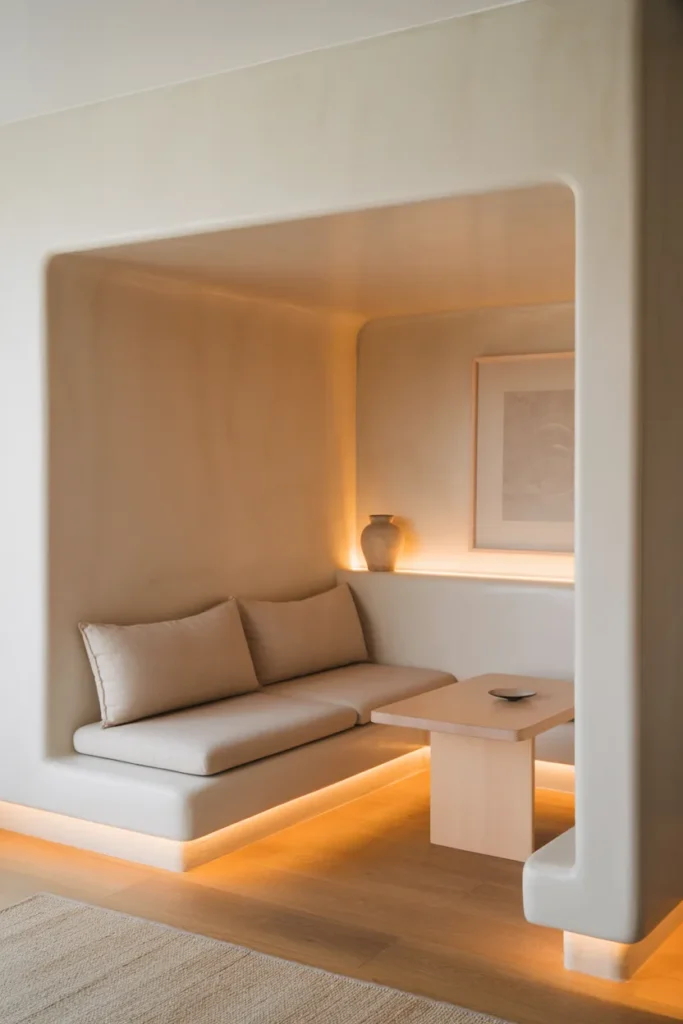
Built-in seating merges function with architecture in minimalist living room design. A wall-mounted bench or window seat saves space and creates an uninterrupted line across the room. The effect feels intentional and sleek.
Use simple upholstery in muted fabrics like sand, oat, or gray. Add a few cushions in textured linen or wool for comfort. Keep colors close in tone for a cohesive flow.
Integrate hidden drawers underneath for extra storage. This design trick keeps the room open while quietly managing clutter a signature move in modern minimalism.
Earthy Tones for Organic Minimalism
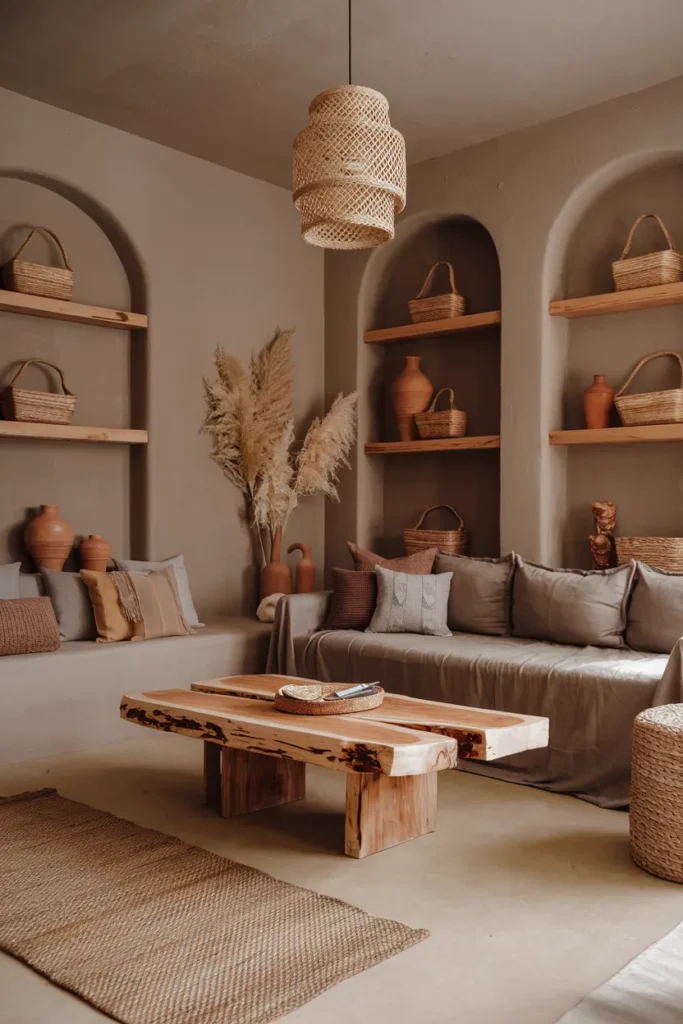
If white feels too stark, shift to earthy tones. Warm beige, clay, soft brown, and muted terracotta bring a grounded, natural vibe to minimalist living room design. These hues make your space feel intimate and soothing.
Pair them with natural textures linen drapes, jute rugs, or oak coffee tables. The blend creates a calm organic minimalism that connects indoor space to nature. Keep accessories subtle to let the colors breathe.
Soft lighting enhances the mood beautifully. When sunlight hits these warm surfaces, the room glows with quiet comfort and effortless charm.
Curved Furniture for Soft Balance
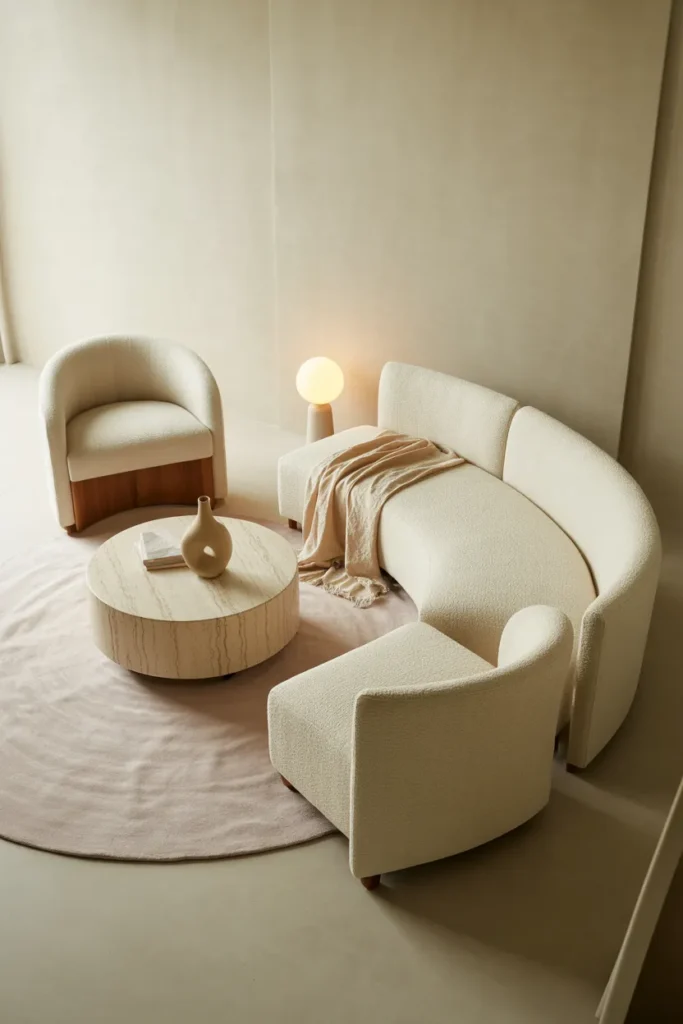
Curves add movement and ease to the straight lines of minimalism. Choose a rounded sofa, arched floor lamp, or circular coffee table to soften the geometry of your space. Each shape flows naturally, creating harmony and rhythm.
Stick to neutral fabrics and light finishes so the curves feel organic, not showy. The gentle contours invite relaxation and make the room more approachable.
Balance them with clean lined pieces nearby to keep proportion. Curved furniture brings emotional warmth to minimalist living rooms it softens structure without losing simplicity.
Open Shelving with Curated Simplicity

Open shelving celebrates minimalism through restraint. Instead of filling every inch, choose a few well curated items a ceramic vase, a sculptural bowl, or a stack of neutral-toned books. The negative space becomes part of the design.
Opt for floating shelves in light wood or white finish. Keep symmetry gentle and organic rather than forced. The result feels balanced yet effortless, allowing each object to breathe within its space.
Natural light enhances this setup beautifully. When sunlight hits smooth ceramics and wooden textures, it adds warmth and depth, turning your minimalist shelf into quiet art.
Soft Lighting with Warm Glow
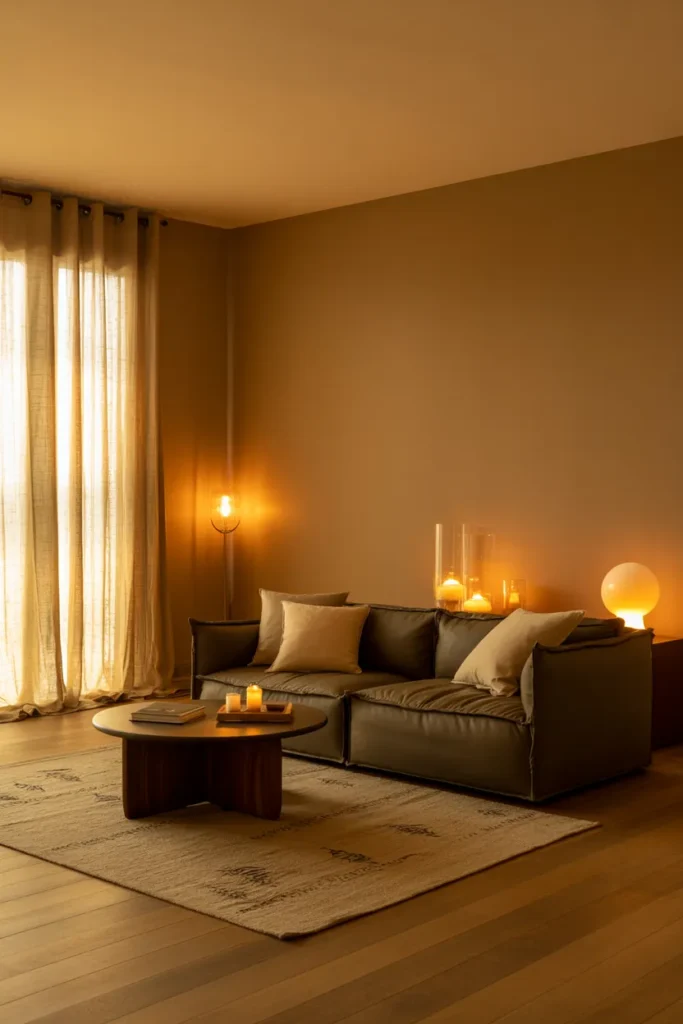
Lighting defines emotion in a minimalist living room. Use soft ambient lamps, diffused wall sconces, or low pendant lights to create layers of gentle illumination. The glow should comfort, not overwhelm.
Warm bulbs around 2700K enhance beige, cream, and gray interiors. Light bounces softly off matte finishes, creating a peaceful evening atmosphere. Avoid harsh white light it breaks the serenity.
Strategically place lamps near seating areas and corners to guide the eye naturally. Each glow becomes a design element, wrapping your minimalist living room in warmth and calm.
Neutral Artwork for Balanced Character
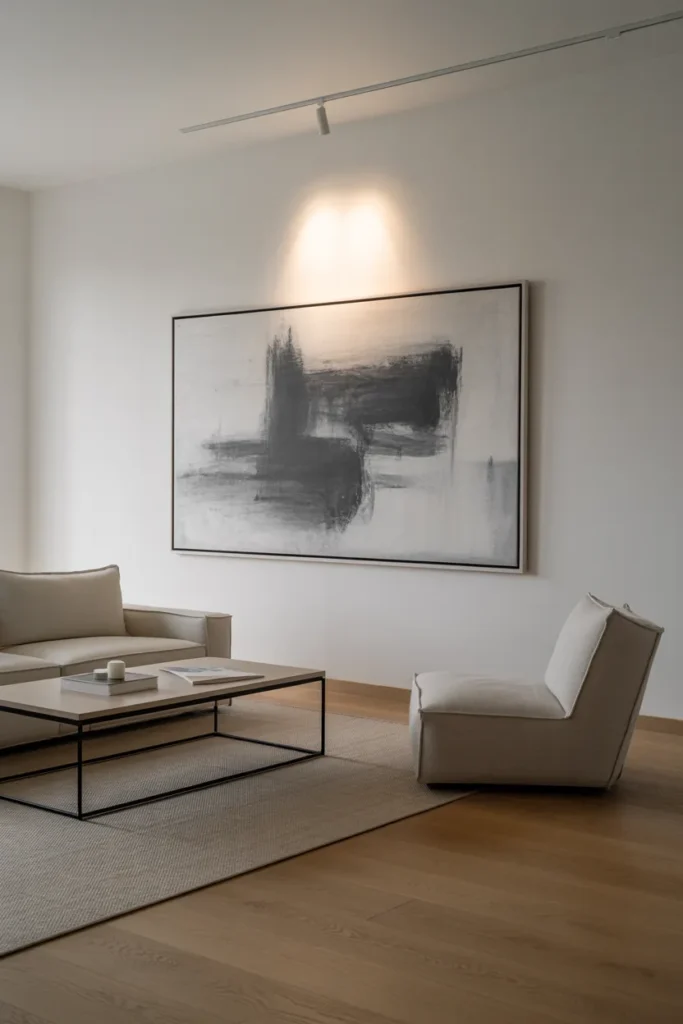
Minimalist art connects emotion to simplicity. Abstract line drawings, soft geometric prints, or monochrome canvases add quiet character without stealing focus. Keep frames thin and finishes matte.
Hang art at eye level with generous white space around it. The breathing room highlights the artwork while preserving minimalism’s clean energy. You don’t need multiple pieces; one well chosen print often says enough.
Neutral artwork complements any color palette, grounding the room in balance. It feels personal yet restrained a visual whisper instead of a shout.
Subtle Pattern Play for Depth
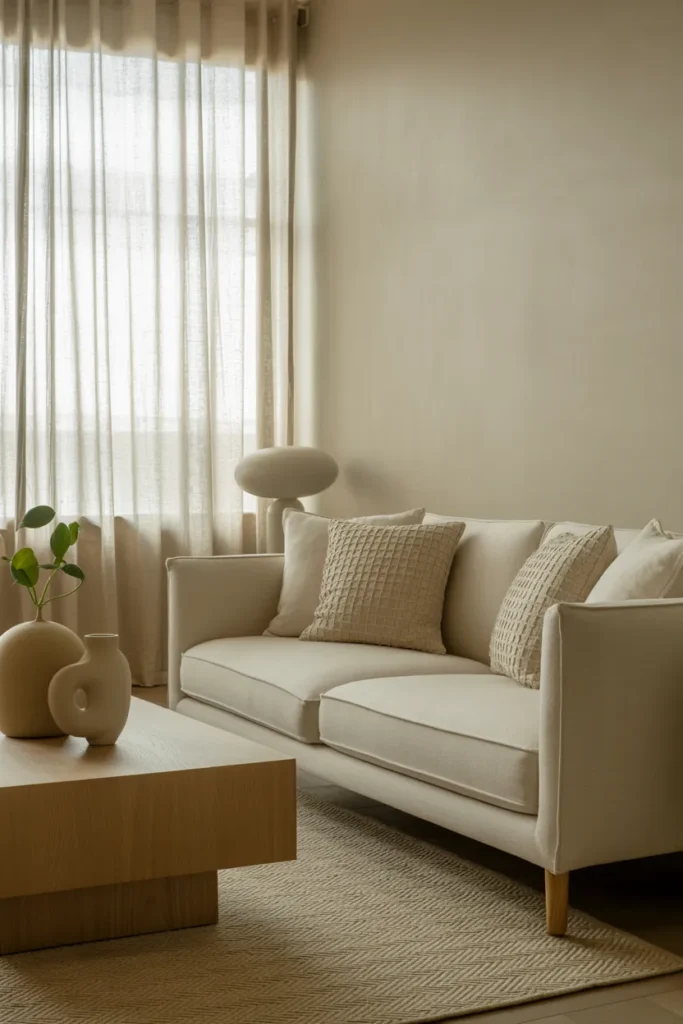
Even minimalism needs a touch of rhythm. Introduce subtle patterns through textiles striped cushions, herringbone throws, or geometric rugs in muted tones. They add life without breaking visual harmony.
Stick with tone on tone designs that blend into your palette. The effect stays soft while still offering dimension. Patterns should feel discovered, not announced.
This gentle layering keeps the space human and relatable. When textures and lines move quietly together, your minimalist living room feels both alive and serene.
Minimalist Decor with Personality
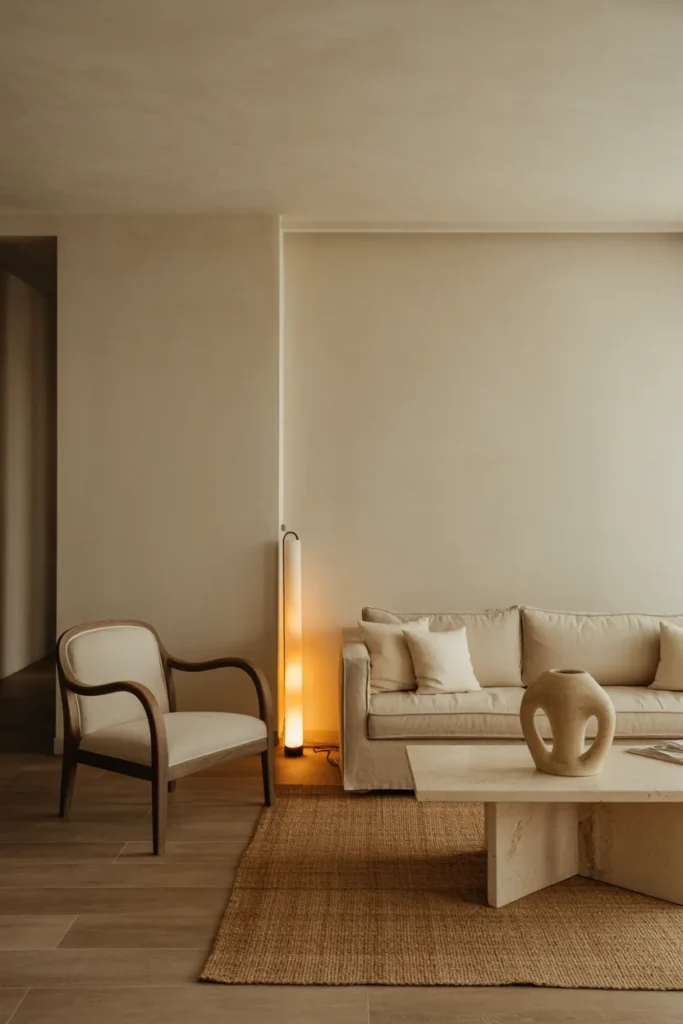
Minimalism doesn’t mean cold or empty it’s about personality expressed through purpose. Choose a few meaningful items: a handmade pottery piece, a travel photo, or a single vintage chair that tells a story.
Display them mindfully. Every item should have space and significance. The goal isn’t to fill gaps but to celebrate simplicity through authenticity.
When your living room reflects who you are calm, intentional, and genuine it transcends trends. That’s the real power of minimalist design: living beautifully with less, but living fully within it.
How do I make my Living Room Minimalist?
Creating a minimalist living room starts with editing what you own. Remove anything that doesn’t serve a purpose or bring you joy. Keep only pieces that add comfort, function, or beauty. The goal is to create open space where the eye can rest and the mind can relax.
Focus on clean lines, simple shapes, and a balanced layout. Choose a neutral color palette soft whites, beige, gray, or warm earth tones that reflects natural light. Furniture should be functional and low profile, leaving plenty of room to move around.
Add warmth through texture instead of clutter. A linen throw, a jute rug, or a wooden coffee table introduces depth without chaos. Keep decor intentional a single plant, framed art, or ceramic vase can complete the look. When everything feels calm and deliberate, your living room naturally becomes minimalist.
Conclusion
Peaceful spaces don’t happen by accident; they’re created through choices that align with how you want to live. Every color, texture, and piece of furniture contributes to the rhythm of your daily life. Minimalism invites you to slow down, breathe deeper, and design with purpose rather than excess.
Your living room becomes more than a showpiece it turns into a reflection of your calm mind and intentional lifestyle. Whether it’s the warmth of natural wood, the glow of soft lighting, or the stillness of open space, your design choices shape how your home feels every single day.
When your surroundings support clarity and comfort, everything else begins to fall into place. A minimalist living room isn’t about having less; it’s about making room for what truly matters peace, beauty, and presence.

